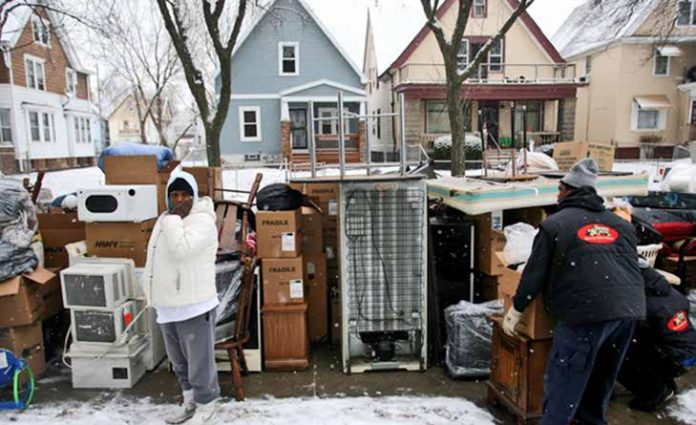20,000 lose homes driving 60,000 into city’s shelters
By Michael Derek Roberts
Despite the well-meaning efforts by Mayor Bill DeBlasio’s Administration, and the fact that evictions in New York City are down by around 18 percent, the city still grapples with a persistent and nagging housing crisis that has spawned an eviction epidemic. And the unintended consequences of this situation are the ugly by-products of crippling poverty, child homelessness, burgeoning rents, landlords unreasonable demands, red-lining, and an established “eviction machine” colluding with landlords that targets low-income and Black communities.
With an average of 20,000 evictions a year in New York City, this crisis – unless arrested – is just getting started. Its already resulted in a human exodus out of the City because families can no longer afford the high rents that’s now sucking up more than 50% of the combined incomes of a family of four. When inflation and other costs are factored in living in New York City for low-income and poor people is an unrelenting constant struggle.
The fact is that today evictions are a major cause of housing instability among low-income New Yorkers. Many reports have concluded beyond a shadow of doubt that evictions are the number one contributor to chronic homelessness, either immediately, or after a household have to “double-up” with family or friends. In fact, the City’s Independent Budget Office (IBO) recently estimated that 28 percent of families in shelters are there because of an eviction.
Overcrowding contributed to another 23 percent. Evictions damage a person’s credit, making it difficult to rent another apartment, creating a barrier to both government-subsidized and private housing.
“This is the Catch 22 problem: hardworking people get evicted because their incomes can’t handle the usurious rents charged by landlords who see getting rid of a poor tenant as a means to do some cosmetic changes to an apartment and then hike the rents that other, newcomer residents, can pay. Evictions for non-payment of rent, because of limited family income, is a major, and still unaddressed problem in areas like Central Brooklyn,” said Pia Raymond and local community leader and housing advocate in Brooklyn.
 The there’s the barrier to legal representation for tenants facing evictions in Landlord/ tenants Housing courts (New York City has recently implemented a program to address this). The most recent data says that across America, 90 percent of landlords have attorneys, but 90 percent of tenants do not. Tenants routinely get kicked out of their apartments for not showing up in court (they can’t afford to take the day off from work and lose income) to defend themselves or don’t know how (ignorance of the system and their rights). The Legal Aid Society in New York did a random experiment that found that eviction warrants declined 77 percent when the tenant had counsel.
The there’s the barrier to legal representation for tenants facing evictions in Landlord/ tenants Housing courts (New York City has recently implemented a program to address this). The most recent data says that across America, 90 percent of landlords have attorneys, but 90 percent of tenants do not. Tenants routinely get kicked out of their apartments for not showing up in court (they can’t afford to take the day off from work and lose income) to defend themselves or don’t know how (ignorance of the system and their rights). The Legal Aid Society in New York did a random experiment that found that eviction warrants declined 77 percent when the tenant had counsel.
Every year in New York City there are more than 150,000 housing court cases. More than 120,000 tenants would qualify for representation under New York’s new law, which offers counsel for households under 200 percent of the federal poverty line (about $50,000 for a family of four). Currently, fewer than 3 in 10 low-income households go to court with a lawyer spawning more than 20,000 evictions each year. Nearly half of all families in homeless shelters are thought to wind up there after eviction.
“Its very clear that in New York City’s greedy and rapacious housing market system the profit motive behind evictions are enormous—especially when the tenant occupies a rent-stabilized apartment that can be deregulated through vacancy. Kicking a tenant out means more money for the landlord. That means evictions eat away the rent-stabilized stock, which is by far the city’s cheapest way to preserve affordable housing,” Ms. Raymond told CARIBBEAN TIMES NEWS.
As a consequence of this compounded situation rising rents make it harder and harder for the homeless – new and long-term – to get back into apartments. Alarmingly, the average length of NYC shelter stay for families with children is over a year. The city’s shelter population is now more than 60,000 —the size of a small U.S. City – all residents in 661 shelters across the five boroughs. And unsurprisingly revealing is that evictions are most prevalent in Black and brown neighborhoods in the city.
Recent data suggests that the majority of evictions are clustered in Central and Eastern Brooklyn: northern Crown Heights, Bedford- Stuyvesant, Brownsville, Flatbush, East Flatbush, and East New York. And in the south and northwest Bronx:(including Morrisania, Claremont Village, High Bridge, Morris Heights, University Heights, and East Tremont. This points to a close relationship between zip codes with high eviction rates and those from which residents are entering shelters because of housing related circumstances. Highest concentrations are in the Bronx overall (and south and northwest Bronx in particular), as well as Central and Eastern Brooklyn. It’s no secret that these are also some of the very poorest and depressed areas of the city.
In fact, research by a prominent sociologist, Matthew Desmond, makes a strong case that evictions perpetuate poverty, especially among Black households, and particularly those headed by women. The city’s zip codes with the highest number of residents living in poverty, particularly Black, Latino, and female-headed households, are often the same as those with the highest eviction rates. There is also a strong correlation between the number of evictions and census tracts with high rates of deep poverty.
Even when controlling for census tract (see below) income tenants residing in census tracts (areas) with a predominantly Black or Latino population are more likely to be evicted than those residing in census tracts that are predominantly Asian or white. Given the relationship between race and evictions, it is not surprising that homelessness disproportionately impacts Black and Latino New Yorkers: 58 percent of New York City homeless shelter residents are Black, 31 percent are Latino, 7 percent are white, and less than 1 percent are Asian.
Finally, the high costs of child care for working parents also adds to the potential for getting evicted from an apartment for non-payment of rent. For example, the average cost of day care services for toddlers can set poor working families back $8,043 to $18,815 a year, according to Care (www.care.com.) That’s very demanding for these families. Also, renters who didn’t go to college, and therefore are likely to earn less money in income, are also almost twice as likely to be threatened by eviction.
[The “Census Tract” is an area roughly equivalent to a neighborhood established by the Bureau of Census for analyzing populations. They generally encompass a population between 2,500 to 8,000 people.





















































 and then
and then